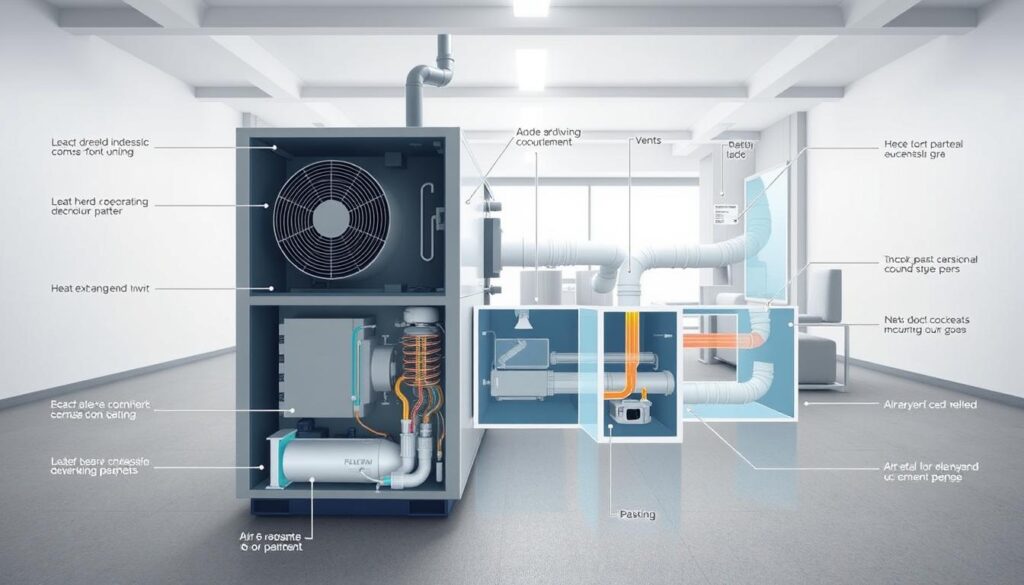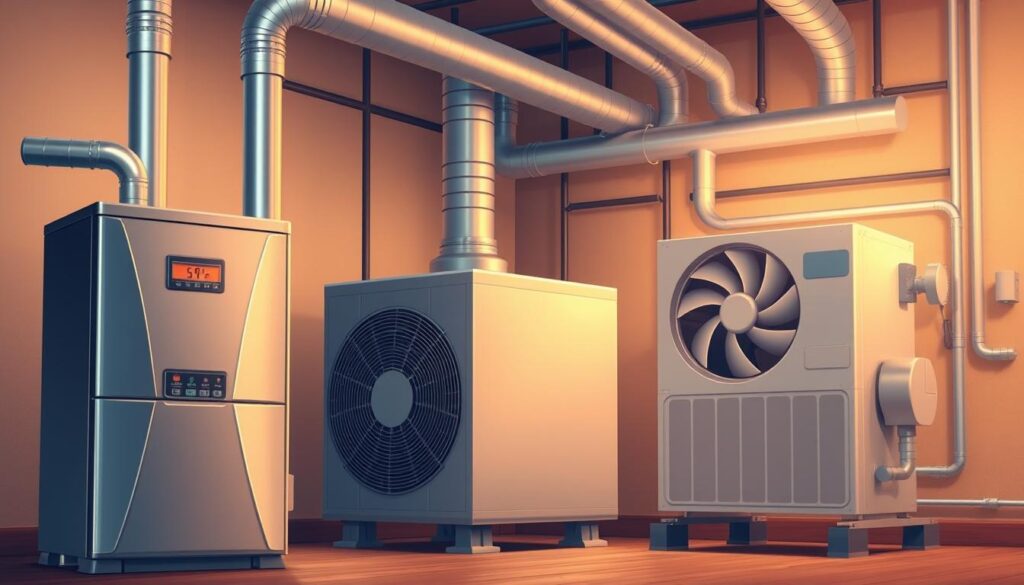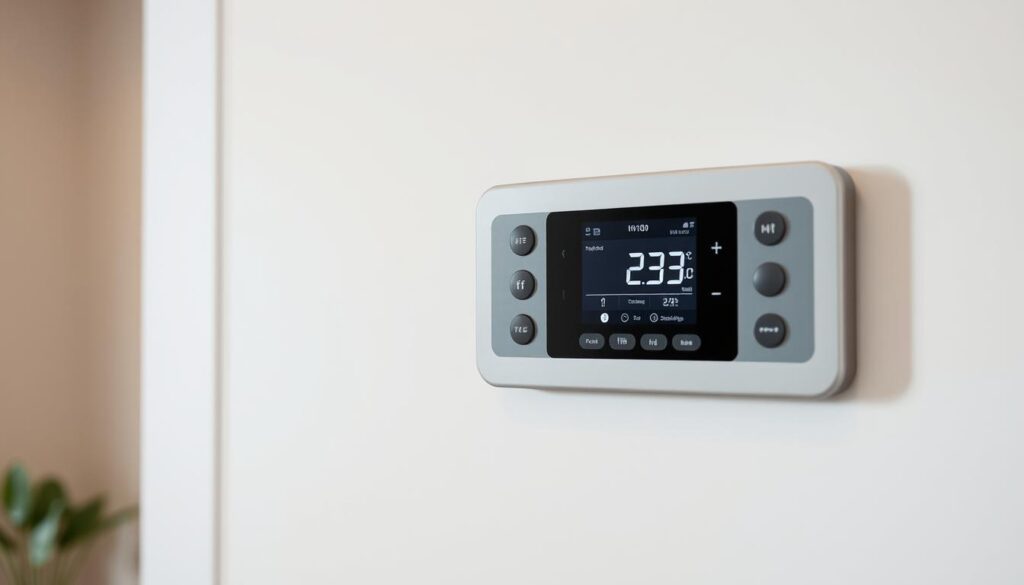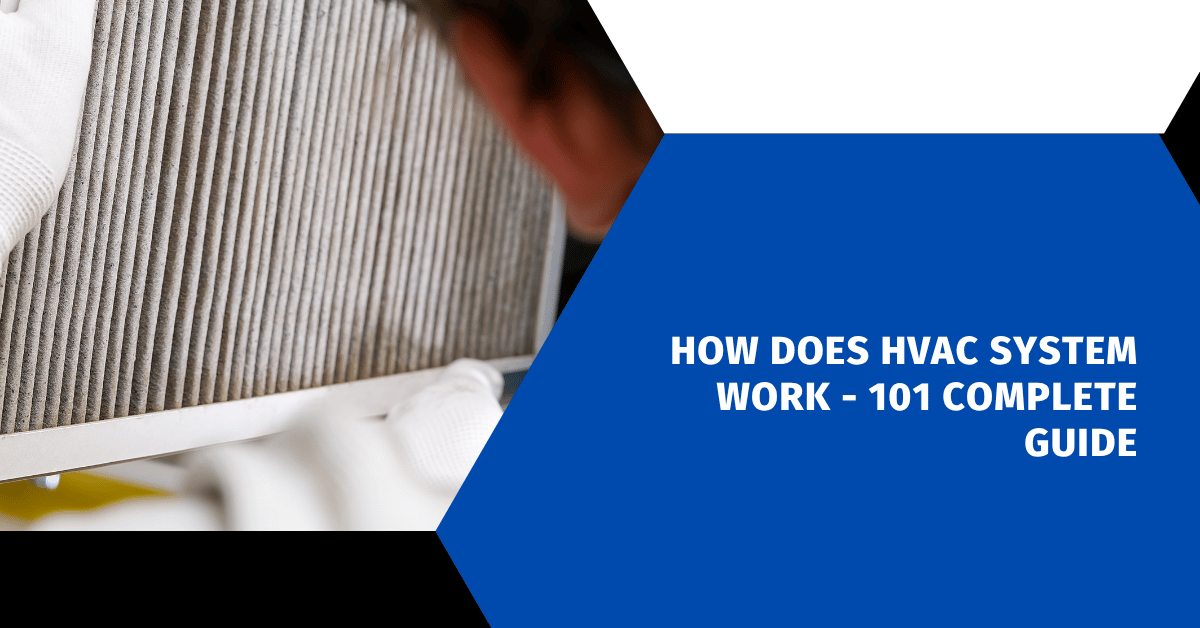Affiliate Disclosure
HVAC Guide Guys is a participant in the Amazon Services LLC Associates Program, an affiliate advertising program designed to provide a means for sites to earn advertising fees by advertising and linking to Amazon.
How Does HVAC System Work? Ever wondered how your home stays comfy in hot summers and cold winters? It’s thanks to the hard work of heating, ventilation, and air conditioning (HVAC) systems. These systems are always working in the background.

Learning about HVAC components can make you appreciate the tech that keeps your home cozy. These systems do more than just control the temperature. They’re complex machines that aim to create the ideal indoor climate.
HVAC systems have three main jobs: they control the indoor temperature, ensure air flows well, and manage humidity and air quality. By handling these tasks, your home becomes a cozy haven, no matter the weather outside.
Each part of the HVAC system, from the blower to the thermostat, is vital. They all work together to keep your home comfortable. This guide will explain how these systems work, whether you want to improve your home’s comfort or just understand the tech behind it.
Key Takeaways
- HVAC systems manage temperature, air circulation, and air quality
- Understanding system components helps improve home comfort
- Modern HVAC technologies focus on energy efficiency
- Regular maintenance prevents system failures
- Different HVAC types suit various home configurations
Table of Contents
Understanding HVAC System Fundamentals
Your home’s comfort comes from a network of heating, cooling, and ventilation. HVAC systems are key to keeping your home just right. They control temperature, humidity, and air quality with great accuracy.
HVAC systems are amazing feats of engineering. They make your home comfortable. They use about 40% of your home’s energy, so they must be efficient to save money.
What is an HVAC System?
An HVAC system keeps your home at the perfect temperature. It stands for Heating, Ventilation, and Air Conditioning. It changes your indoor space with advanced temperature control.
The Role of HVAC in Home Comfort
- Regulates indoor temperature
- Controls humidity levels
- Improves air quality
- Ensures consistent comfort
Basic Operating Principles
The hvac heating and cooling processes use complex systems. They involve heat transfer and air movement. These systems work together to create the ideal indoor climate.
| HVAC Component | Primary Function |
|---|---|
| Thermostat | Temperature regulation |
| Furnace | Heating air |
| Air Conditioner | Cooling and dehumidifying |
| Air Handler | Circulating conditioned air |
Did you know? Keeping your HVAC system in good shape can cut energy use by up to 30%. This can save you money on bills while keeping your home comfortable.
“Comfort is not just about temperature, it’s about creating the perfect indoor environment.” – HVAC Expert
Core Components of Your HVAC System
Your home’s HVAC system is made up of many parts working together. These parts help keep your home comfortable. Knowing about these components can help you take better care of your home’s climate.
- Furnace: The heating powerhouse of your system
- Air Conditioner: Responsible for cooling and humidity control
- Heat Pump: Versatile component for both heating and cooling
- Air Handler: Circulates conditioned air throughout your home
- Ductwork: Network for air distribution
Each part is key to a comfortable home. HVAC systems are used in about 87% of U.S. homes. This shows how important they are for modern living.
| Component | Primary Function | Efficiency Impact |
|---|---|---|
| Furnace | Heating | 80-98% efficiency |
| Heat Pump | Heating/Cooling | Up to 50% energy reduction |
| Air Conditioner | Cooling | 6% of residential electricity |
“Understanding your HVAC system’s components is the first step to efficient home comfort management.”
Modern heat pumps can work in temperatures as low as zero degrees Fahrenheit. This shows how HVAC systems have improved. Regular maintenance can make your system 5% to 15% more efficient.
Learning about your HVAC system’s parts helps you talk better with experts. It also helps you make smart choices about upkeep and upgrades.
Explore Our HVAC Shop
Looking for top-rated HVAC tools, parts, and accessories? Visit our shop and find the perfect solution for your needs.
Visit the ShopHow Does HVAC System Work
Your home’s HVAC system is a complex network of components working together. They maintain comfortable indoor temperatures and air quality. Understanding how an HVAC system works can help you appreciate the complex processes happening behind the scenes.
The HVAC system operates through three primary functions: heating, cooling, and air distribution. Each process involves sophisticated mechanisms. These mechanisms are designed to regulate your home’s environmental conditions effectively.
The Heating Process
The heating process starts when your thermostat signals the need for warmth. Modern furnaces can decrease energy usage by up to 50% compared to older models. Gas furnaces distribute warm air through ductwork. Many now use efficient PVC venting systems instead of traditional chimneys.
- Furnace activates when temperature drops below set point
- Fuel (gas or electricity) generates heat
- Blower fan circulates heated air through home
The Cooling Process
During the hvac cooling process, refrigerant plays a key role. Evaporator coils hold chilled liquid refrigerant, which absorbs heat from indoor air. The compressor acts like an electric pump, pressurizing the refrigerant and facilitating heat transfer.
| Cooling Component | Primary Function |
|---|---|
| Compressor | Pressurize refrigerant gas |
| Condenser Coil | Release absorbed heat outside |
| Evaporator Coil | Absorb indoor heat |
Air Distribution and Ventilation
Proper hvac air distribution is critical for maintaining indoor comfort. Ductwork serves as the respiratory system of your HVAC, circulating heated or cooled air throughout your home. Ventilation helps maintain air quality and prevents airflow issues.
Proper ventilation can prevent up to 30% of HVAC airflow problems.
By understanding these processes, you can better appreciate the sophisticated technology. It keeps your home comfortable year-round.
The Heating System: Furnace and Heat Pump Operations
Knowing how your heating system works is key to keeping your home cozy. Your heating system is essential for warmth during the cold months. Furnaces and heat pumps are the main types used in homes.

Heat pumps are a new way to heat and cool your home. They move heat from outside to inside. Air-source heat pumps can provide heating in winter and cooling in summer, making them very efficient.
“Heat pumps use up to 50% less energy for heating compared to traditional electric or gas heating systems.” – ENERGY STAR
- Heat pumps operate effectively in temperatures as low as 20°F
- Most heat pumps qualify for ENERGY STAR certification
- Can work with existing home ductwork or as mini-split systems
Furnaces are another heating option. They make heat by burning gas or propane and spread it through ducts. Furnaces are great in very cold places, heating quickly and strongly.
| Heating System | Energy Efficiency | Climate Suitability |
|---|---|---|
| Heat Pump | 50% less energy consumption | Moderate to mild climates |
| Gas Furnace | Standard efficiency | Cold climate regions |
When picking between heat pumps and furnaces, think about your local weather, home size, and energy bills. Both have their own benefits for keeping your home at the right temperature.
Explore Our HVAC Shop
Looking for top-rated HVAC tools, parts, and accessories? Visit our shop and find the perfect solution for your needs.
Visit the ShopAir Conditioning Components and Functions
Your home’s HVAC cooling system has many parts that work together. They keep you cool during the summer. Knowing how these parts work helps you take better care of your air conditioning.
The air conditioning system is amazing. It removes heat and humidity from your home. Several key parts are at its heart, each playing a special role in cooling your space.
Compressor: The Heart of Cooling
The compressor is the main part of your air conditioner. It uses a lot of energy and is the most expensive part. Its main jobs are:
- Pumping refrigerant through the system
- Compressing refrigerant into a high-pressure gas
- Starting the heat transfer process
Condenser Coil: Heat Rejection Specialist
The condenser coil is outside. It’s key to the cooling process. It gets rid of 70-90% of the heat, making cooling work well.
Evaporator Coil: Cooling Magic Happens Here
The evaporator coil is inside your home, near the furnace. This is where cooling magic happens. It makes warm air cool and refreshing.
“Proper maintenance can improve your air conditioning system’s efficiency by up to 20%” – HVAC Experts
Refrigerant Cycle Explained
The refrigerant cycle is a never-ending process. It has four main stages:
- Compression
- Condensation
- Expansion
- Evaporation
Pro tip: Regular maintenance can extend your air conditioning unit’s lifespan to 15-20 years and prevent costly repairs.
Thermostat Control and System Regulation
Your HVAC thermostat is like the brain of your home’s heating and cooling system. It keeps an eye on the temperature and adjusts it to keep you comfortable.

Today’s HVAC thermostats are much smarter than they used to be. They help save energy and keep your home just right.
- Programmable temperature settings
- Remote control via smartphone apps
- Learning capabilities that adapt to your preferences
- Energy usage tracking and reports
Knowing the right temperature can make your thermostat work better. In winter, keep it between 68°F and 72°F. In summer, aim for 75°F to 78°F.
“A smart thermostat can reduce heating and cooling costs by up to 15%, making it a wise investment for energy-conscious homeowners.”
There are different types of HVAC thermostats, each with its own benefits:
| Thermostat Type | Key Features | Energy Savings |
|---|---|---|
| Mechanical | Basic temperature control | Minimal |
| Digital | Precise temperature settings | 5-10% |
| Programmable | Schedule-based temperature management | 10-15% |
| Smart | AI-driven learning, remote control | 15-20% |
Choosing a high-tech HVAC thermostat can change how your home uses energy. It keeps your home comfortable and saves you money. The right thermostat makes your heating and cooling system work better.
Explore Our HVAC Shop
Looking for top-rated HVAC tools, parts, and accessories? Visit our shop and find the perfect solution for your needs.
Visit the ShopAir Distribution System: Ducts and Vents
Your HVAC system’s ability to keep your home comfortable depends on its air distribution network. The ductwork acts as your home’s circulatory system. It ensures conditioned air reaches every corner of your living space.
HVAC air distribution involves a complex network of supply and return ducts. These ducts work together to maintain optimal indoor comfort. They move air throughout your home, manage temperature, and support air quality.
Supply and Return Ductwork Design
Understanding ductwork is key for efficient HVAC ventilation. Here are important considerations for a good air distribution system:
- Round ducts are 15-20% more efficient in airflow compared to square ducts
- Proper duct sizing prevents negative pressure scenarios
- Flexible ducts offer cost-effective and energy-efficient solutions
Ventilation Efficiency Insights
Your HVAC system’s performance can be greatly impacted by duct quality. Here are some critical statistics:
| Duct Performance Metric | Impact |
|---|---|
| Air Leakage | 20-30% energy waste possible |
| Duct Cleaning Frequency | Every 5 years recommended |
| Efficiency Improvement | Up to 15% with regular maintenance |
“Properly designed ductwork is the backbone of an efficient HVAC system.”
Proactive maintenance and understanding your home’s air distribution system can lead to improved comfort, better air quality, and reduced energy costs.
Different Types of HVAC Systems
Choosing the right HVAC system for your home means knowing the different options. Each type has its own benefits and challenges, fitting various needs.
- Split Systems: The classic setup with indoor and outdoor units
- Very common in homes
- Offers flexible heating and cooling
- Ductless Mini-Split Systems: Great for controlling temperature in specific areas
- No need for ductwork
- Perfect for keeping certain rooms at different temperatures
- Packaged HVAC Units: All-in-one solutions for small spaces
- Great for smaller areas
- Has everything you need in one unit
- Hybrid Systems: Use more than one energy source
- Switch between electric heat pump and gas furnace
- Helps save energy
“The right HVAC system can significantly impact your home’s comfort and energy consumption.”
Your choice depends on several factors. These include your home’s size, the local climate, your budget, and how much you want to save on energy. Talking to HVAC experts can help you pick the best system for your needs.
Energy Efficiency and System Performance
Your HVAC system is key to home comfort and energy use. Learning about hvac energy efficiency can save you money and help the environment. Today’s systems aim to work well while using less energy.
HVAC systems use about 40% of energy in homes and businesses. Making your system more efficient can cut down on energy use and lower bills.
Factors Affecting HVAC Energy Efficiency
- System age and maintenance condition
- Insulation quality
- Ductwork integrity
- Equipment rating and technology
- Climate and local temperature variations
Energy-Saving Tips for Maximum Efficiency
- Regular Maintenance: Get professional checks every year
- Install a smart thermostat for better temperature control
- Improve home insulation
- Use ceiling fans for better air flow
- Change air filters every 3 months
“Efficient HVAC systems can reduce energy consumption by up to 30% through optimized control strategies.”
Important efficiency measures include SEER (Seasonal Energy Efficiency Ratio) and AFUE (Annual Fuel Utilization Efficiency). In 2023, the best heat pumps have SEER ratings from 20-25. Top furnaces can hit AFUE ratings of 90% or more.
By focusing on hvac energy efficiency, you can make your home more comfortable. You’ll also cut down on energy costs and your carbon footprint.
Explore Our HVAC Shop
Looking for top-rated HVAC tools, parts, and accessories? Visit our shop and find the perfect solution for your needs.
Visit the ShopMaintenance and Care Requirements
Keeping your HVAC system in top shape is key for home comfort and efficiency. Regular maintenance can stop costly breakdowns and make your equipment last longer. By using a smart maintenance plan, your system will work its best.
- Replace air filters every 1-3 months
- Clean air vents and registers regularly
- Check thermostat settings seasonally
- Inspect outdoor unit for debris
- Listen for unusual system noises
Regular HVAC maintenance makes a big difference. Dirty filters can block airflow and make systems use up to 15% more energy. Keeping up with maintenance boosts efficiency and cuts down on repair costs.
| Maintenance Task | Frequency | Potential Benefits |
|---|---|---|
| Filter Replacement | Every 1-3 months | Up to 15% energy efficiency improvement |
| Professional Inspection | Annually | 75% reduction in system breakdown likelihood |
| Outdoor Coil Cleaning | Twice yearly | Up to 30% enhanced cooling capacity |
“Preventive maintenance is always less expensive than emergency repairs.” – HVAC Professionals’ Wisdom
Getting professional HVAC maintenance at least once a year is a must. Experts can spot issues early, saving you money and possibly adding 5-10 years to your system’s life.
Pro tip: Create a maintenance calendar to keep track of when to change filters, schedule inspections, and do seasonal checks.
Conclusion
Knowing how HVAC systems work is key to a comfy and energy-saving home. HVAC systems use about 40% of a building’s energy. This knowledge can save you money and improve your home’s performance.
Regular maintenance can make your system 5% to 15% more efficient. This can save you hundreds of dollars each year. By learning about your HVAC system, you can make better choices about its care and use.
Properly sized and cared for systems can last 15 to 20 years. This means reliable comfort and energy management for you. For the best results, consider professional HVAC services like Aire Serv.
They can guide you through HVAC system complexities, from installation to maintenance. With nearly 87% of U.S. homes using air conditioning, a good system is essential. Taking care of your HVAC ensures it works well, saves energy, and keeps your home comfortable for years.
The HVAC industry is always changing, with new technologies and ways to save energy. Staying up-to-date helps you make smart choices for your home. A well-maintained HVAC system is an investment in your comfort, health, and wallet.

